The Lea Navigation has always been teeming with life, but in the early years I went there it was mainly wild, both in the water and on the banks, where paths on the back rivers were often blocked by rampant brambles, vicious nettles and other weeds, and home for a wide range of birds and insects. But you could often walk for a mile or two and not see another person, enjoying what was then an inner-London wilderness.
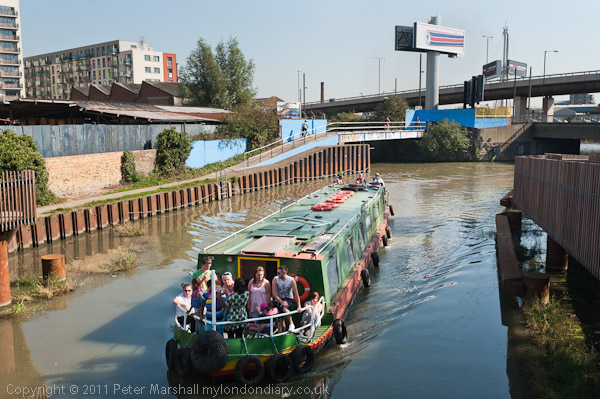
Now the area has been tamed, domesticated and generally tidied up, and most of the life seems to be guided walks and people on bikes with enough gears to face Everest. There were several boats full of people on Saturday afternoon tours too. The area may be rather less interesting than it used to be, almost sterile (and thousand of tons of its earth covering dug up, sterilised and then replaced anywhere on the site) but it is now a visitor attraction, part of the London tourist trail.
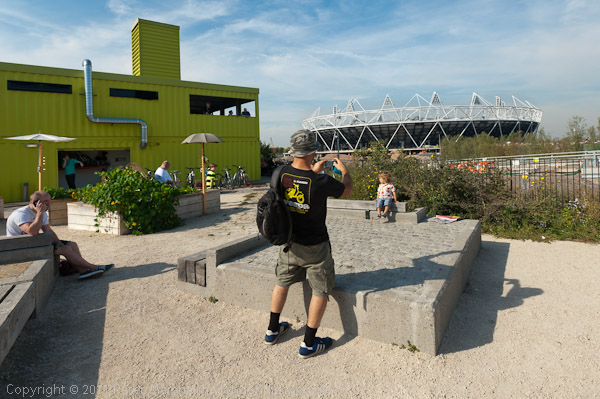
As I walked along the Greenway (itself an earlier marketing revision of the Northern Outfall Sewer) overlooking the London Olympic site, a couple of Japanese held out a camera towards me and asked if I would take their photograph. Of course I obliged, though I find these compact digitals with an invisible image on the screen at the back hard to manage. A few yards on, I photographed a man taking a picture of his young son on a rather arty looking seat with the stadium in the background.
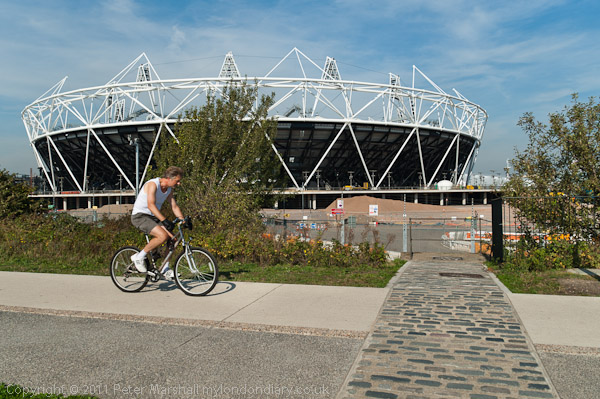
Going past the stadium was a man in a hurry, perhaps practising for the Olympics, though more likely trying to keep fit. The atmosphere on the Greenway was quite different to that a year or so ago, when every few yards there was a security man, and photographers sometimes got harassed. There were a few about, and one did come and tell me I couldn’t take pictures, but it was his idea of a joke, though given my many previous experiences I wasn’t over-amused.
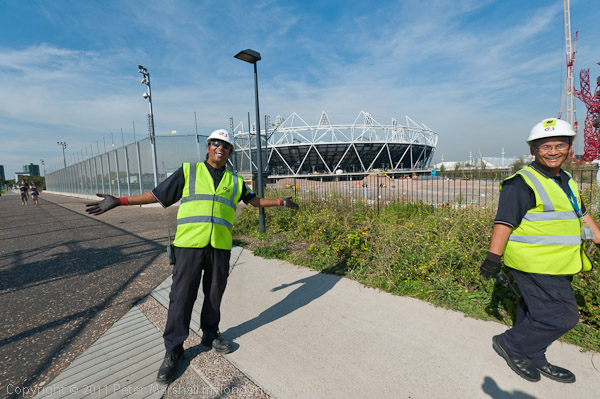
I’m not quite sure why his colleague was flying, but these things happen. I was actually there to take part in an event with four other photographers, all talking about our work around what is now the Olympic site – and in my case particularly about the book ‘Before the Olympics’ – but I’d brought the D700 and a couple of lenses with the aim of making a few panoramas, and I took a few other pictures as well.
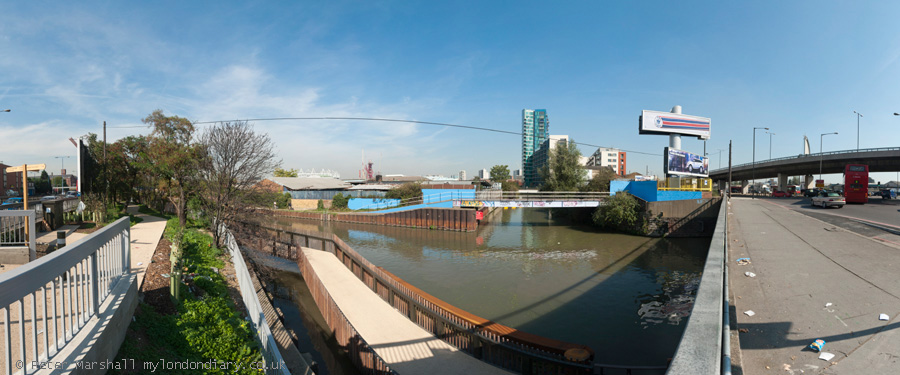
This isn’t perhaps the most interesting of those I made – and you can see these as well as the other work from the afternoon in Lea Navigation & Olympic Site on My London Diary.
The picture above, which shows a new suspended footpath that goes under the Bow flyover, has the file name 20111001-d0120eqr209-900s.jpg which is perhaps rather a mouthful, but a good illustration of how I’ve now taken to naming these panoramic files.
- ‘20111001‘ needs no explanation, simply the date in the order that sorts correctly.
- ‘-d‘ is really a hangover from the days when photographers used film and any scans from my colour negatives would have a ‘c’ in the filename to remind me they were colour. Now everything is digital, so perhaps I don’t really need the ‘d’.
- ‘0120‘ is simply a sequence number, allocated by Lightroom to my digital files in the order that they are imported (most days these start at 0001.) This particular panoramic image was actually stitched together from seven exposures, numbered 0120-0126, and takes the number of the first in the series (all of which were vertical format 16mm images on FX format.)
- ‘eqr’ is a three letter short form of the projection used, in this case equirectangular. Other possibilities include ‘rec’ (rectilinear), ‘cyl’ (cylindrical. ‘ved’ (vedutismo) etc.
- ‘209’ is the horizontal angle of view when I stitched the panorama; sometimes the actual angle in the image may be slightly less due to a little cropping, but it gives a good indication. Images do rather more often get considerably cropped top and bottom after processing to give a straight edge, so I decided there was no point in including the vertical angle of view in the name.
- ‘900’ is the width in pixels. I don’t give the width for the original full-size file, so this is one way of specifying that this is a reduction.
- ‘s’ stands for ‘sRGB’. AdobeRGB is my default work space both in camera and in Photoshop, and files that end without a letter are in that default space.
This is a naming convention that I’ve found very useful, although there are some things that it doesn’t tell me, and others might like to use longer conventions, that would include things like the focal length, camera orientation, number of separate frames etc. But 20111001-d0120eqr209-900s seemed to me a good compromise.